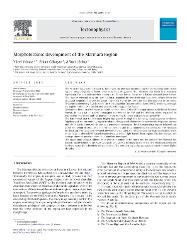| dc.contributor.author | Yılmaz, Yücel | |
| dc.contributor.author | Gokasan, Erkan | |
| dc.contributor.author | Erbay, A. Yücel | |
| dc.date.accessioned | 2019-06-27T08:05:11Z | |
| dc.date.available | 2019-06-27T08:05:11Z | |
| dc.date.issued | 2010 | |
| dc.identifier.issn | 0040-1951 | en_US |
| dc.identifier.uri | https://hdl.handle.net/20.500.12469/1042 | |
| dc.identifier.uri | https://doi.org/10.1016/j.tecto.2009.05.012 | |
| dc.description.abstract | The Marmara Region of northwest Turkey covers the Marmara Sea Basin and the surrounding lands. In the region morphologically different areas may be distinguished. The Marmara Sea Basin is a structural depression. The land to the north is known as the Thrace-Kocaeli Peneplain a flatland elevated above a horst. This may be referred to as the Istanbul Horst bounded by two strike-slip fault zones which define the structural boundaries of two sea basins | en_US] |
| dc.description.abstract | the Black Sea in the north and the Marmara Sea in the south. The southern boundary fault is part of the North Anatolian Transform Fault Zone (NAFZ) which cuts through the region in the E-W direction and extends to the Aegean Sea Region. The land to the south of the Marmara Sea is a plateau about 300 to 800 m high known as the Bursa-Balikesir Plateau. It has a rather rugged topography represented by NW and NE trending ridges separated by depressions. The ridges and the depressions correspond to horsts and grabens respectively. The data reveal that the Marmara Region has passed through the following morphotectonic evolution. Together with the surrounding region it suffered a long period of denudation between the Oligocene and the end of the late Miocene which formed a regionwide peneplain. The N-S extensional regime followed this phase and began to produce a horst-graben system and thus fragmented the peneplain. The flat-lying erosional surfaces have been elevated above the horsts. Later the NAFZ reached the Marmara Region. In the initial stage it affected NW Anatolia extensively as a wide right-lateral shear regime. This has evolved and through time the present narrow fault zone has developed. The major morphological difference between the regions to the north and the south of the Marmara Sea Basin is mainly related to the NAFZ. As a plate boundary it formed a barrier to the N-S extension saving the northern sector from the effect of the extension. The southern region has gradually elevated to much higher altitudes. (C) 2009 Elsevier B.V. All rights reserved. | en_US] |
| dc.language.iso | eng | en_US |
| dc.publisher | Elsevier Science Bv | en_US |
| dc.rights | info:eu-repo/semantics/openAccess | en_US |
| dc.subject | Morphotectonics | en_US |
| dc.subject | Marmara Region | en_US |
| dc.subject | Bosporus | en_US |
| dc.subject | North Anatolian Transform Fault | en_US |
| dc.title | Morphotectonic development of the Marmara Region | en_US |
| dc.type | article | en_US |
| dc.identifier.startpage | 51 | en_US |
| dc.identifier.endpage | 70 | |
| dc.relation.journal | Tectonophysics | en_US |
| dc.identifier.issue | 1-4 | |
| dc.identifier.volume | 488 | en_US |
| dc.department | Yüksekokullar, Yabancı Diller Yüksekokulu | en_US |
| dc.identifier.wos | WOS:000279624200005 | en_US |
| dc.identifier.doi | 10.1016/j.tecto.2009.05.012 | en_US |
| dc.identifier.scopus | 2-s2.0-77953807833 | en_US |
| dc.institutionauthor | Yılmaz, Yücel | en_US |
| dc.relation.publicationcategory | Makale - Uluslararası Hakemli Dergi - Kurum Öğretim Elemanı | en_US |
















